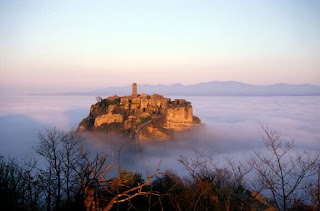 |
| Civita And Walkwat |
Civita di Bagnoregio, Viterbo is located in northern Lazio, just south of the Tuscany border. This "hill town" came to our attention as one of our guests were seeking a scenic place to visit on their way to Tuscany. We say "hill town" because this place is way up there perched on top of a very high hill. An amazing feat of medieval engineering. Civita di Bagnoregio is actually two remote towns. Civita is on a hill accessible only by a long stone walkway that begins at the end of the road from neighboring Bagnoregio. The photos show the long walking bridge. A modern idea of marrying contemporary design to the towns antiquity was "imagined" not construction not begun.
 |
| The "Imagined" New Walkway |
Civita is perched atop a volcanic hill just south of Orvieto and to the east of Lago Bolsena. It is about 1 1/2 hour north of Rome. It' a dramatic setting and tenuous too. Civita clings to the edge of a crumbling cliff of tufa rock that has slowly etched by wind, sun, rain and seismic activity that is not new to this town or region. Indeed, Civita is yet another example of endangered Italian cultural heritage threatened by earthquakes as we have seen in the north. Just a little shaking here, which has not happened in some time, and old stone facades are weakened and the cliffs of Civita di Bagnoregio squeeze in ever more.
 |
| A Dreamy Place At The Right Time |
Civita di Bagnoregio was founded by Etruscans about 2.500 years ago in a time when geologically it was not so difficult a location. During the Etruscan period, in fact, it was an important city for its position along an ancient road connected to a dense network of trade routes and traces of Etrusca are found in the town's necropolis beneath the belvedere of San Francesco Vecchio and cave of Saint Bonaventure which was transformed into a chapel during the Middle Ages. Saint Bonaventure is one of the most important figures of Civita, who was miraculously cured from a serious illness by St. Francis of Assisi, it is said.
 |
| Circa Mid 1800's |
During the Dark Ages the town passed through hands from the Lombards to the Franks and finally passed under the Papal State, as everything did in this region with the fall of Rome. From 740 to 1695 Civita di Bagnoregio grew with imitations and peacefully prospered through domination by Orvieto. But in 1695 Civita's descent began through a serious earthquake that compelled many residents to leave the city. The continuous seismic activity through the centuries since brought a long series of landslides and departures. Compared to its halcyon days, Civita di Bagnoregio retains a very small number of people - it is said there are only 14 year round - who are determined to keep this corner of history little alive.
 |
| A Day For Donkeys |
La Tonna, The Slow Palio
Twice a year, during the first Monday of June and the second Monday of September on the main square of Civita a donkey race with jockeys takes place. This race begins in the afternoon, after a brief procession in the town. In ancient times, the donkey was considered an intelligent animal compared to its role today as a "jackass". At La Tonna the donkey regains its protagonist role.
Living Nativity
During the Christmas holidays through the 6th January more than 50 characters in costume perform the birth of Jesus Christ. The performance begins at 17:00 hour and ends at 19:00 on the 26th December, 1st January and 6th January.
A Local Meal
You may wish to have a little something to eat at Antico Forno.
No comments:
Post a Comment